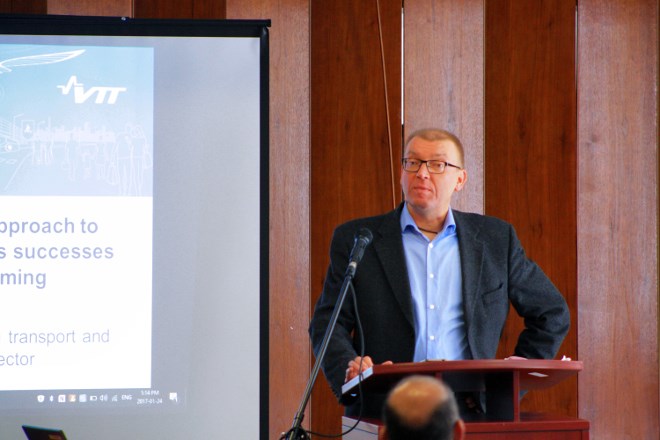By Graham Strong for Northern Ontario Business
Biofuels could be the right solution at the right time for Northern Ontario.
That’s the message that a delegation of companies from Finland brought to various area businesses, government agencies, and municipalities including at least one First Nation during a visit to Thunder Bay.
“We’re promoting the European know-how,” said Matti Virkkunen, a research scientist at VTT Technical Research Centre of Finland and part of the delegation. “We’re looking for research projects and companies that we can do joint ventures with.”
The delegation attended the Building Biomass Value Chains Workshop, held at Lakehead University on January 24 and hosted by Biomass North.
During the workshop, Virkkunen provided an overview of what the biomass economy might look like in Canada based on a project now underway in La Tuque, Que. That pilot is building a demonstration biorefinery to determine the feasibility of such a plant, both in terms of technical practicality and economic benefits.
The plan is to convert forest residues – which can include the leftover from forest harvesting, thinning initiatives, and sawmills, among other sources – into 200 million litres of biodiesel per year.
Jarno Valkeapää, a counsellor in the commercial and trade affairs department with the Finnish embassy, accompanied the group to Thunder Bay. He said that the purpose of the visit was essentially to show stakeholders what possibilities exist in Northern Ontario.
“It’s a know-how transfer on (how to use) the waste biomass you have in a sustainable way,” Valkeapää said. “Then hopefully, of course, that would create business opportunities for the technology.”
Finland has built its biomass economy over the last 50 years.
Necessity is the mother of invention, and in this case, the necessity was to make the best use of the fuel around them: wood.
Until recently, Canada’s experience has been markedly different in that respect.
“You’ve been blessed with all the energy you need,” Valkeapää said. “Natural gas, oil, hydro: the driver is different than what Finland had. We needed to create these models because we needed energy. We didn’t have oil.”
Skyrocketing energy costs throughout Northern Ontario have changed the picture, though, making alternative energy sources more attractive.
“Take First Nations, most of them are fully dependent on diesel. Money goes out, and no jobs are created. There are small-scale entrepreneurship models that could be benchmarked,” Valkeapää said.
Indeed, many First Nations across Northern Ontario use diesel generators for electricity, which is is an expensive solution – especially for fly-in communities, where the total yearly bill reportedly can exceed $1 million.
It’s also a solution that doesn’t always meet demand.
NCC Development is one First Nations-owned company that’s currently building micro solar grids to reduce diesel dependency.
Biomass energy presents yet another option and is an already proven concept in the region with Ontario Power Generation (OPG) converted both its Atikokan and Thunder Bay generators from coal to biomass.
On a smaller scale, Confederation College in Thunder Bay uses a biomass boiler system to heat the campus and provide research opportunities.
Whitesand First Nation is planning to build a biomass-fuelled power plant that will generate electricity for itself as well as the nearby towns of Armstrong and Collins, with the help of private sector partners.
The developing bioeconomy in Northern Ontario is part of what Virkkunen called heat entrepreneurship.
“Heat entrepreneurship is about small private companies starting to provide heat made from wood. That’s something we’ve been learning since the 1990s,” Virkkunen said. “In 30 years, you learn a lot. We can supply Canadians with shortcuts. They don’t have to take all the detours we’ve taken.”
The delegation had meetings scheduled with officials from communities including Marathon and Whitesand and with companies and organizations like OPG, KBM Resources and True Grit Consulting.
Virkkunen stressed that when looking at alternative energies such as biofuels, solar, and wind power, it doesn’t have to be one or the other – sometimes the best solution is a combination of both. Finland’s emphasis on wood is simply due to circumstance: long and cold winters, shorter days, and lots of trees – environmental characteristics that Finland very much shares with Northern Ontario.
“You can be confident if you have the wood chips in your shed. That’s why Finland has taken a strong interest in wood,” Virkkunen said.




